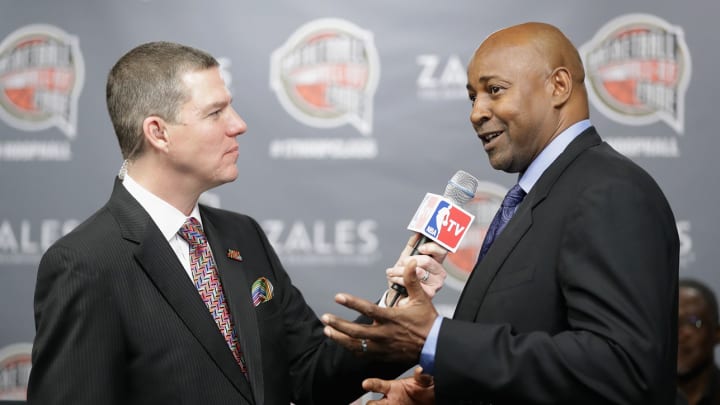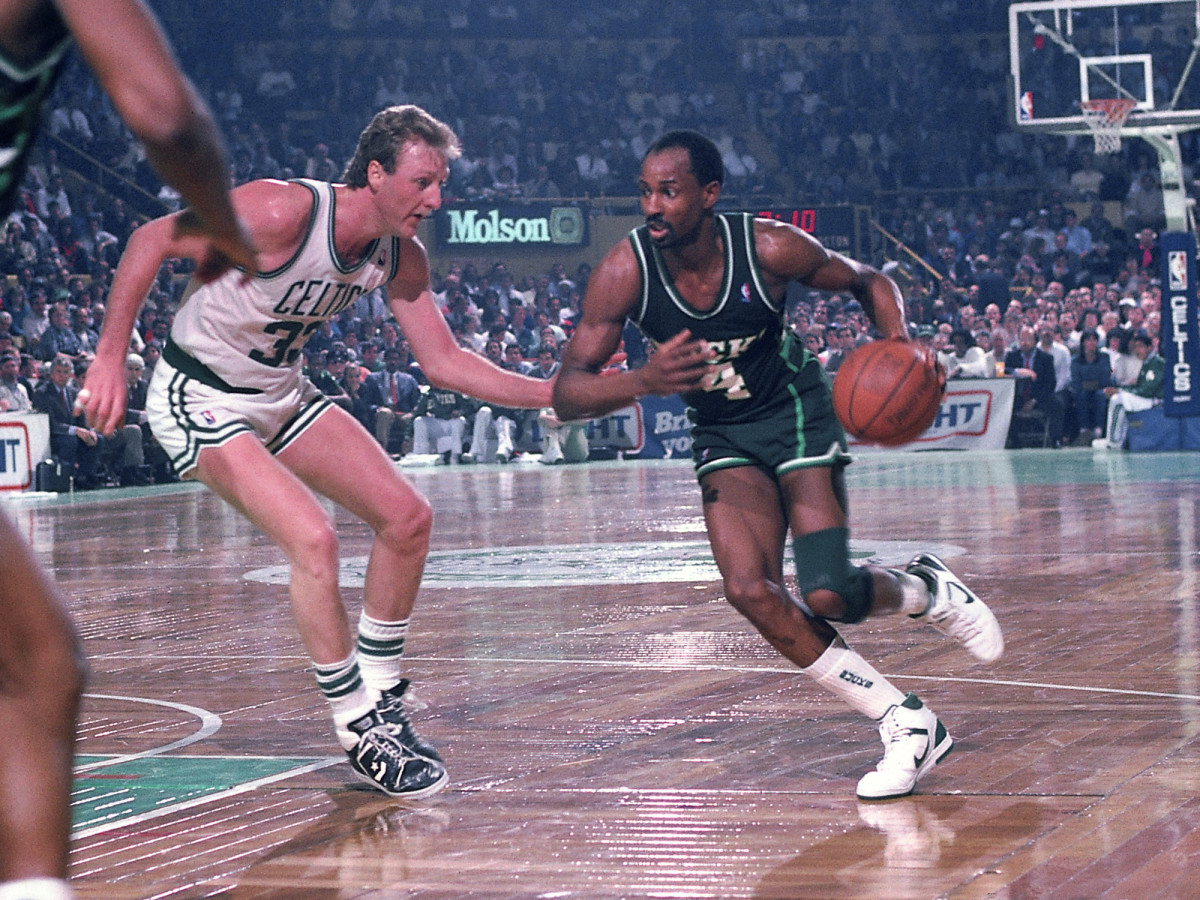Why Sidney Moncrief Deserves To Be In The Hall of Fame

Most of my friends will tell you that my basic attitude toward Halls of Fame is that there’s nothing wrong with any of them that a massive sinkhole wouldn’t cure. One of the few exceptions is the National Freshwater Fishing Hall of Fame in Hayward, Wisconsin, part of which is shaped like a giant muskellunge. Visitors can pose for pictures in the muskie’s mouth, in which someone sensibly installed a guard rail so that, from the ground, it looks as though the muskie has had some advanced orthodonture done. I like that one a lot.
But the rest of them are open invitations to pretentious moralism and preening self-regard. Baseball’s is by far the worst. If it’s not the endless dark nights of the soul pondering the PED question, it’s the moronic annual argument of why someone can’t be a unanimous inductee on the first ballot because nobody ever was before. And this was before analytics invaded the process, by which to pretentious moralism and preening self-regard was added…math. God, people. It’s a museum. It’s for old things and dead people. You are not the admissions committee for the Round Table. Get over yourselves.
Chris Webber, Tracy McGrady among 2017 Basketball Hall of Fame finalists
There are three sports arguments in which I never indulge. First, what does the “valuable” in “Most Valuable Player” mean? Second, who will win the Heisman Trophy? And third, who should or should not be in a Hall of Fame and why. I know people who glory in these disputes, and not all of them have radio talk-shows, either. So it is a rare thing when I line up to make a case for someone that I believe belongs in a Hall of Fame. But, over the weekend, I learned that one of the finalists for this year’s induction into the Basketball Hall of Fame is Sidney Moncrief, and so my firm principles went right out the window, because there are not that many basketball players whose play I have enjoyed more than I did watching Sidney Moncrief play the game.
He first came to national attention on the cover of this very magazine. “High On The Hogs,” was the headline, and Moncrief, then a star at Arkansas, was shown rising from the floor with a look on his face that made you wonder if he were about to dunk a basket or kill a vampire. Along with Marvin Delph and Ron Brewer, Moncrief was one of the Three Basketeers, a hokey neologism that nonetheless caught on and shoved Arkansas basketball upwards into the apex of Eddie Sutton’s great run along the Pig Trail in Fayetteville. (They were also called The Triplets, a more distinguished monicker for sure that was hung on them by Al McGuire, who’d just begun his television career.) From there, he went on to play in the NBA, mostly for the Milwaukee Bucks, for 12 seasons. He was a five-time All-Star and he was the league’s Defensive Player of the Year twice.
But, for me, Moncrief’s great ability was the amount of pure smooth that he brought onto the floor. Tough and athletic, he always played within the vast bounds of his natural ability. That cover shot notwithstanding, he was never outwardly ferocious, but try to get the ball when Sidney decided that you shouldn’t have it. He would lock you up and look very cool doing it. But, mainly, Moncrief belongs in the Hall of Fame as a witness to, and a participant in, the generation of players who helped save the NBA.

He came into the league in the same year as Magic Johnson and Larry Bird. (He and Bird had collided once in college, and we’ll get to that later.) Because of the transcendence of those two players, the rest of that generation gets a little lost. (For simplicity’s sake, let’s make the generation begin with the players who came into the league with Johnson and Bird and end with the arrival of Michael Jordan. Or, roughly, 1979 to 1984.) Moncrief was drafted fifth behind Johnson in the 1979 draft, Bird shrewdly having been drafted by the Celtics when he became eligible the year before his last season at Indiana State. The following year brought Kevin McHale to the Celtics and Darrell Griffith to Utah. Isiah Thomas came in the year after that. And, in 1984, the motherlode came in. The draft produced four players out of the first 16 chosen who ended up in the Hall of Fame. The NBA took off in the 1980’s because, in addition to Magic and Larry, a flood of talent poured into the league to take advantage of the explosion of visibility that those two brought to the NBA.
At the same time, of course, the path to a championship for people like Moncrief was effectively blocked. The Bucks had Philadelphia and Boston in the way, and then Boston and Atlanta. In 1983, the Bucks swept Bird’s Celtics out of the playoffs when the Boston players pretty much quit on head coach Bill Fitch. But Milwaukee was eliminated by Philadelphia in the Eastern Conference finals. So Moncrief’s candidacy is said to be hamstrung by the fact that he doesn’t have A Ring, which has become the magic conjuring device that produces a Hall Of Fame career.
Breakaway Podcast: Exploring The NBA From The Inside Out
This is a shame because there is something to be said to having been a witness to, and a participant in, the saving of professional basketball in this country, to have been one of the people who helped the NBA go from a bankrupt landfill to an international soft power super-weapon. At the time of the Big Bang, Sidney Moncrief stood close to the fire and came out a star. But he already was that, if you watched college basketball, which was just then beginning to go nova itself. That came through one game that, in the history of the Final Four, has been drowned out by almost forty years of hype, but one that connoisseurs talk about the same way that music fans once talked about The Basement Tapes. In that game, one that was so impeccably played that it’s hard even now to believe the statistics, Sidney Moncrief was one ungainly basket away from helping to make Magic-n-Larry never happen at all.
In 1979, Arkansas was sent to the Midwest Regional in Cincinnati and seeded second to undefeated Indiana State. The two teams barreled through the bracket; Arkansas’s nine point win over Louisville was the closest game either team played. Both Brewer and Delph had graduated, leaving Moncrief as the last Basketeer. He had had a rousing season, averaging 22 points per game and leading the team in rebounding despite being only 6'4". But he was lost in the frenzy surrounding Bird and the undefeated Sycamores. The game was a close run thing, and it was played at a level rarely seen in tournament play. Both teams shot more than 56% from the field; Arkansas shot nearly 64%. The two teams combined turned the ball over only 17 times. Bird went for 31 on 12–for–22. Moncrief hit 10 of 16 shots for 22.
The Boogie Butterfly Effect: The Trade That Upstaged All-Star Weekend
With the game tied at 71 and a little over a minute left, Arkansas guard U.S. Reed got tangled up and, somehow, got called for traveling. (The video is so unclear that it looks like the perfect time for a no-call.) In these days before the shot clock, Indiana State sat on the ball, waiting to get Bird a shot at the end to win the game. But, for a full minute, Moncrief put Bird in jail. He overplayed him, denying him on both hands because Bird was so murderously ambidextrous. These were two high-level athletes playing at the top of their games and Moncrief was winning. Finally, in something like desperation, ISU guard Steve Reed went up as if to shoot but, instead, dished the ball into the lane to a guy named Bob Heaton. When he was very young, Heaton’s left-hand was mangled in a farming accident. Nevertheless, Heaton somehow shoved the ball up with that same hand and it bounced a couple times before it fell through to win the game. Later, Bird joked that he was going to use some of his signing bonus to buy Heaton a new jump shot.
Looking back now, this is one of those What-If-Lee-Hadn’t-Sent-Pickett moments in history. Suppose Heaton had missed and Arkansas had won in overtime? Magic and Moncrief would have been a nice championship game, but it wouldn’t have been the sea change moment for both college and professional basketball that it became. Bird wouldn’t have had the championship game loss to Michigan State that haunted him until he was able to lay that ghost in the 1984 NBA playoffs. But the stars stayed in their courses and everything about basketball changed. Now, though, all the history has been written. The legacy of Magic-n-Larry is set in stone. But there were enormously talented supporting actors in that long narrative. They played their roles with style and grace. Sidney Moncrief is at the head of that class. He needs to be in the Hall of Fame because the witness of his talent needs to be honored.
